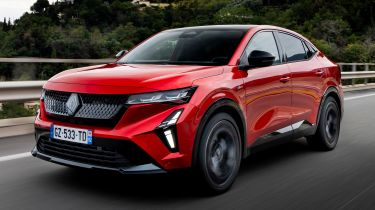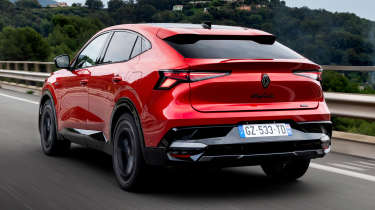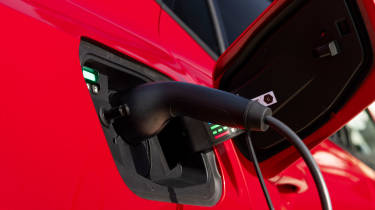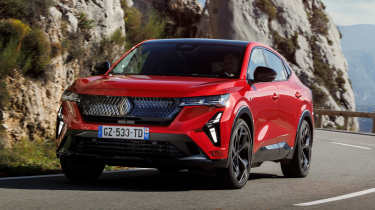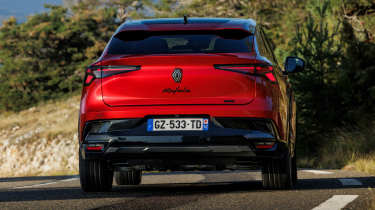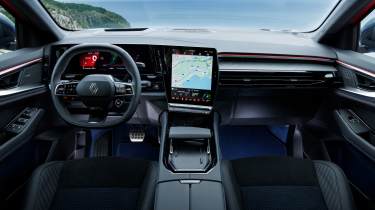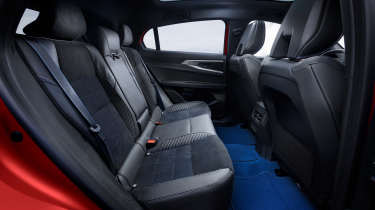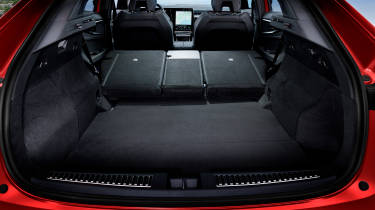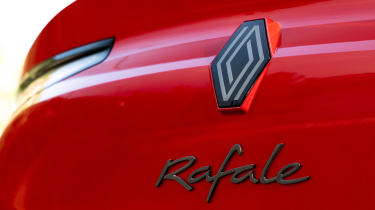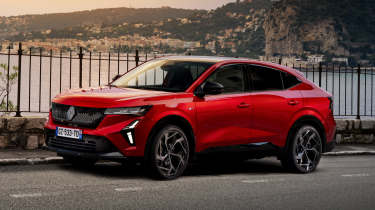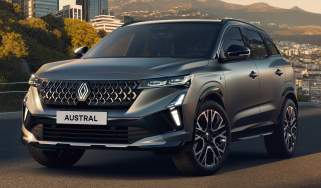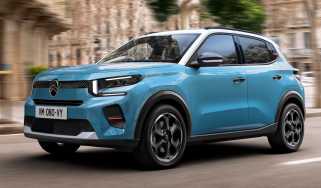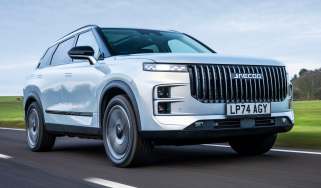Renault Rafale review – a practical coupe-SUV that punches upwards
“The Renault Rafale is a stylish and practical coupe SUV, but it’s not the last word in premium feel”
Pros
- Quirky French design
- Brilliant infotainment
- Practical for a coupe-SUV
Cons
- Harsh engine noise
- Numb driving feel
- Rivals feel more premium
Verdict – is the Renault Rafale a good car?
There’s certainly a lot to like about the Renault Rafale – it’s stylish inside and out, includes some quirky, futuristic features and is very spacious despite its rakish appearance. However, while it’s certainly upmarket it doesn’t feel quite as premium as some rivals, and the driving experience is a bit numb. Renault promised the latest plug-in hybrid version would be enjoyable to drive, but fun isn’t the main reason to choose it.
Renault Rafale models, specs and alternatives
Just when you thought every SUV niche in the Renault range was already filled, the French brand released another model known as the Renault Rafale. It’s a very en-vogue coupe-SUV which sits above the boxier Renault Austral in terms of price in the lineup – the Rafale starts from just over £42,000.
Its styling adheres to Renault’s latest design theme, with a more angular look than many of the brand’s designs that came before it. Rather than the C-shaped lights of the Renault Arkana, the Rafale’s headlights are broken up into separate elements across the front end, flanking a grille made up of diamond-shaped elements that form an interesting pattern.
It’s clear Renault is trying to offer the Rafale as a more upmarket model in the coupe-SUV market, offering a little French flair to help it stand out against cars like the Audi Q5 Sportback and square up to other quirky French offerings like the Peugeot 3008 and Citroen C5 X.
The Renault Rafale initially launched solely as a self-charging hybrid, but a plug-in hybrid joined the lineup a few months later. The self-charging hybrid known as the E-Tech 200 uses a 1.2-litre petrol combustion engine paired with two electric motors for a very respectable 197bhp power figure for a car of its size, propelling the Rafale from 0-62mph in 8.9 seconds. The plug-in hybrid is called the Renault Rafale E-Tech 300 and gets a more potent 296bhp propelling it from 0-62mph in just 6.4 seconds.
Frugal fuel economy is the Renault Rafale’s forte, though, so its hybrid system is capable of returning up to 60.1mpg and low CO2 emissions of between 105 and 107g/km, which is pretty impressive for a mid-size SUV. The plug-in hybrid model can return up to 404.3mpg, emits just 15g/km of CO2 on paper, and is capable of driving for up to 59 miles on electricity alone, so it’s more versatile.
There are three trim levels on offer for the hybrid model, starting with Techno, moving up through Techno Esprit Alpine and Iconic Esprit Alpine – the plug-in hybrid comes in one of two trims: Techno Esprit Alpine or Atelier Alpine. As standard all cars get a 9.3-inch head-up display, a 12-inch infotainment screen, a rear-view camera and other tech, while spending around £2,500 more for the Iconic Esprit Alpine gets you a 360-degree camera, autonomous parking and an uprated Harman Kardon sound system as well as other extras.
Unfortunately, Renault doesn’t perform particularly well in Driver Power customer satisfaction surveys, and reliability for the brand is pretty average according to its rankings. Safety is a plus point for the Rafale though, because it achieved the full five stars when it was crash-tested by Euro NCAP in July 2024.
|
Trim levels |
Power options |
|
|
MPG, running costs & CO2 emissions
The Renault Rafale is a car that’s exclusively offered as a hybrid or plug-in hybrid model. The standard hybrid’s small three-cylinder engine is backed up by two electric motors; one of these drives the front axle, while the other acts much the same as a mild-hybrid system, taking the strain off the small engine, which can also act as a generator. All of this makes the Rafale very frugal and economical to run, particularly for a car of its size.
If you want to be able to drive the Rafale for some of the time solely on electricity, then the plug-in hybrid is the model for you. This version has a range of up to 59 miles, and official fuel economy is up to 404.3mpg. That jaw-dropping figure is a bit misleading though, because that’s only really possible if you regularly keep the Rafale PHEV charged up – run it when it’s out of electricity and you won’t come close to that figure – around 50mpg is more realistic. It’s also the version with the lowest CO2 emissions figure at just 15g/km.
|
Model |
Fuel economy |
CO2 emissions |
|
Renault Rafale E-Tech |
60.1mpg |
105-107g/km |
How efficient is the Renault Rafale in the real world?
Renault says the Rafale is capable of running for up to 80% of the time on electric power alone, and regenerative braking technology helps to recoup much of the energy lost from slowing down and put it back into its batteries. We’re quite confident in Renault’s claim because when we drove the Rafale around the streets of Seville, Spain, we barely noticed the combustion engine kick into life at all, with the electric motors doing almost all the work.
How much will the Renault Rafale cost in tax?
The Renault Rafale won’t be the cheapest car to tax as it will incur the extra surcharge for cars that cost over £40,000, with the lineup starting from just under £42,000. That means that on top of the cost to tax a hybrid as an alternative fuel vehicle (£180 in 2024) you will also have to pay £410 per year from year two to year six of the car’s life. If you buy the Rafale as a company car, your best bet is to go with the plug-in hybrid model because it has the lowest CO2 emissions and therefore sits in a low BiK (Benefit-in-Kind) tax band.
What will the Renault Rafale cost to insure?
The Renault Rafale sits in insurance group 30 out of 50, so it should be quite reasonable to insure for a coupe-SUV of its size. For reference, the Audi Q5 starts from group 31 rising to group 41, though the equally quirky but much less powerful Citroen C5 X starts from group 20 in its most basic form, while the plug-in hybrid version of this car rises to group 31.
Engines, drive & performance
The Renault Rafale shares its platform with the Renault Austral, but despite sharing many parts, the French marque has tuned the Rafale’s suspension for a slightly different feel. First of all, the track width – the distance between two wheels on one axle – has increased for a slightly more aggressive stance that decreases body roll; it’s certainly done the job because there’s very little to speak of.
We first drove the Rafale in standard E-Tech hybrid 200 guise, where we were left disappointed. The steering is very numb, so it’s not the most involving car to drive on winding roads despite its somewhat sporty appearance.
The Rafale E-Tech plug-in hybrid 300 boasts four-wheel drive, a more potent powertrain and more sophisticated suspension system (in the Atelier Alpine specification). This reads the road ahead of you and adapts to it in real time. Unfortunately, the system seems to sacrifice a lot of the body control we mentioned before in exchange for comfort, though it never seems to be successful in that endeavour. As a result, it feels unsettled over bumps and imperfections cause it to wobble about.
Put the system into Sport or Dynamic, however, and the Rafale stiffens up a bit resulting in more composure, coming at the expense of some of its ability to absorb imperfections. It never feels too uncomfortable, but is notably firmer than in Comfort. The problem is, we don’t think these settings make the Rafale any more enjoyable to drive.
The Rafale comes with four-wheel steering on Techno Esprit Alpine models and above, dubbed ‘4Control’, which makes for a particularly tight turning circle of just 10.4 metres – that should make it particularly easy to manoeuvre in urban environments. The problem is that it does make the car feel rather disconnected at lower speeds, which can take getting used to.
At speed the four-wheel steering can also make the Rafale feel as though it’s losing grip at the rear end, so you have to remind yourself of what it’s doing and trust the system at first. The good news is that the four-wheel steering settings can be tweaked through the touchscreen – ours was set to maximum, so drivers might be able to find a more appropriate middle ground. In the plug-in hybrid, the system feels a bit less skittish than in the standard hybrid.
Hybrid models
The Rafale originally launched as a sole self-charging E-Tech 200 hybrid model, but a plug-in hybrid Rafale E-Tech 300 4x4 arrived later down the line. The standard E-Tech hybrid uses a 1.2-litre three-cylinder engine paired with two motors – one of these sits on the front axle to drive the front wheels and another assists the engine to take off some of the strain and improve fuel economy. The system produces 197bhp which isn’t a small power figure, but on the move, there’s some lag in its response which does not make for a particularly involving drive.
The plug-in hybrid Rafale E-Tech 300 4x4 packs 296bhp, all-wheel drive, adaptive suspension and a sportier handling setup, according to Renault, but despite the extra grip it never really feels poised and isn’t much more fun to drive spiritedly.
While the car is being propelled by its electric motors it’s very quiet and refined, but once the combustion engine kicks in under hard acceleration, it produces a gruff noise which upsets that serene experience.
|
Model |
Power |
0-62mph |
Top speed |
|
Renault Rafale E-Tech 200 |
197bhp |
8.9 seconds |
111mph |
|
Renault Rafale E-Tech 300 |
296bhp |
6.4 seconds |
111mph |
Interior & comfort
With Renault gunning for a premium big-car experience, it has its work cut out to challenge rivals from the likes of Audi. Most of the Rafale’s interior is shared with the Renault Austral, and the good news is that it feels well put together – the bad news is that while many of the material choices are interesting, such as dyed cork or slate on the dash, none of it feels quite as premium as the materials used on its German rivals.
There are some interesting features, nonetheless, such as the optional ‘Solarbay’ sunroof. It has a hi-tech feature which allows you to turn the glass from transparent to opaque at the touch of a button rather than via a mechanical blind – the technology has been around for a while, but has only so far been seen on supercars and luxury EVs from companies such as Lotus, so it’s a neat addition that feels premium.
Is the Renault Rafale infotainment and sat-nav system easy to use?
The Renault Rafale gets the brand’s OpenR Link infotainment system which we think is one of the best on the market at the moment – it’s based on Google’s software which makes it very intuitive to use as it’s laid out like the menus on an Android smartphone, so it’s easy to adapt to. The 12-inch portrait infotainment screen and 12.3-inch digital driver’s display used in the Rafale are sharp and vibrant, and everything loads quickly with fast response times. The Google Maps app comes built-in while there are up to 50 other third-party apps available to download. If you’d prefer, there’s also wireless Apple CarPlay and Android Auto compatibility.
Key features | |
|
Techno (E-Tech hybrid 300 only)
|
Techno Esprit Alpine (Techno plus..)
|
|
Iconic Esprit Alpine (Techno Esprit Alpine plus…)
|
Atelier Alpine (E-Tech plug-in hybrid 300 only)
|
Boot space, practicality & dimensions
Despite the fact the Renault Rafale is a coupe-SUV and therefore has a sloping roofline, it offers plenty of head space for passengers. It’s just as long and has the same wheelbase as the Renault Espace sold in mainland Europe, but while that car has seven seats, the Rafale has just five, so occupants are also spoilt for legroom.
There are handy practical features dotted around the cabin – the rear armrest has two cup holders, USB-C charging ports and even useful smartphone holders. The latter should be good for when passengers want to rest their arms but watch a film on a long journey.
|
Size comparison | |||
|
Model |
Length |
Width |
Height |
|
Renault Rafale |
4,710mm |
1,866mm |
1,613mm |
|
Audi Q5 Sportback |
4,689mm |
1,893mm |
1,633mm |
|
BMW X2 |
4,567mm |
1,845mm |
1,590mm |
|
Peugeot 3008 |
4,542mm |
1,895mm |
1,641mm |
Does the Renault Rafale have a big boot?
The Renault Rafale boasts a larger boot than many of its rivals such as the Peugeot 3008 and Audi Q5, with 535 litres available with all the seats up. There’s added underfloor storage, which increases the boot size to 647 litres. Fold down the rear seats and you’ll free up a cavernous 1,709 litres of cargo space, making the Rafale very useful indeed when you need it to lug around bulky items.
|
Boot space comparison | |
|
Model |
Boot space |
|
Renault Rafale |
535 litres |
|
Audi Q5 Sportback |
510 litres |
|
BMW X2 |
515 litres |
|
Peugeot 3008 |
520 litres |
Reliability & safety
The Renault Rafale is an all-new model for the brand and it’s too early to say what reliability will be like for the coupe-SUV. Renault, however, has performed quite poorly in recent editions of our Driver Power customer satisfaction survey, coming behind many rivals in 28th place out of 32 brands in 2024.
Reliability was fairly average, with around 24.4% of Renault owners reporting an issue with their car in the first year of ownership, most of which were electrical issues. The brand scored best when it came to its infotainment system, exterior and interior styling and low running costs, the latter of which should prove even more impressive with the Rafale’s hybrid tech.
How safe is the Renault Rafale?
The Renault Rafale was crash-tested by Euro NCAP in July 2024, receiving the full five-star rating. Adult and child occupant protection was rated at 87% and 83%, respectively. In the Vulnerable Road Users protection category, the Rafale received 69%, which was the lowest rating it got across the board. It achieved good scores for its safety assistance tech, which was awarded 87%.
The Rafale comes with a comprehensive list of safety kit including blind sport warning, traffic sign recognition with speed alert, active emergency braking which can apply the brakes autonomously if you’re about to have a collision, a lane departure warning and keep assist system, a driver attention alert system and occupant safe exit alert, which warns you as you leave the vehicle onto a road where another vehicle is approaching.
Should you buy a Renault Rafale?
We think the Renault Rafale is an undoubtedly stylish coupe-SUV. It’s much better at catering to this niche market sector than the smaller, and slightly underwhelming Renault Arkana, and yet it still boasts a practical, usable design that isn’t significantly compromised by its sloping roofline.
The problem is that while we love its infotainment system and it comes chock full of technology including that futuristic panoramic sunroof, it can struggle to feel quite as premium as many rivals, though it will definitely appeal if you’re a fan of quirky French design.
Another low point is the Renault Rafale's driving dynamics. It just doesn't offer enough fulfilment from behind the wheel, even in plug-in hybrid form with its Alpine-tuned suspension, which we expected might be a little more engaging but was unfortunately not.
What is the Carbuyer pick of the Renault Rafale range?
Of the full hybrid versions, Iconic Esprit Alpine costs just £2,500 more than the Techno Esprit Alpine and includes a few decent upgrades such as the premium Harman Kardon sound system, powered tailgate, 360 camera and nicer upholstery, so it might be worth springing for it.
Renault Rafale alternatives
Renault has pitched the Rafale as a more upmarket car than many other cars in its lineup, so as a result it has a mix of rivals from traditional mainstream brands like Peugeot and other premium coupe-SUVs from well-established German rivals. The sizes of these can vary and you might find the Rafale is larger than some of its rivals because they’re more of a match in terms of price.
How we tested the Renault Rafale
We first tested the Renault Rafale in May 2024 on the roads of Seville, Spain and then again in November 2024 we drove a left-hand drive plug-in hybrid 300 model in Nice, France.
Which Is Best?
Cheapest
- NameE-Tech Full Hybrid Techno 5dr Auto
- Gearbox typeSemi-auto
- RRP£37,990
Most Economical
- NameE-Tech PHEV Techno Esprit Alpine AWD 5dr Auto
- Gearbox typeSemi-auto
- RRP£45,585
Fastest
- NameE-Tech PHEV Techno Esprit Alpine AWD 5dr Auto
- Gearbox typeSemi-auto
- RRP£45,585
